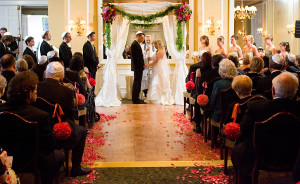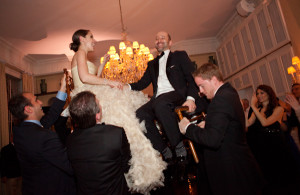A traditional Jewish wedding is full of meaningful rituals, symbolizing the beauty of the relationship of husband and wife, as well as their obligations to each other and to the Jewish people. Here are some of the traditions for Jewish weddings.
Kabbalat Panim
It is customary for the couple not to see each other for one week preceding the wedding. This increases the anticipation and excitement of the event. Therefore, prior to the wedding ceremony, they greet guests separately. This is called “Kabbalat Panim.” At this time there is a tradition for the mother of the bride and the mother of the groom to stand together and break a plate. The reason is to show the seriousness of the commitment ― just as a plate can never be fully repaired, so too a broken relationship can never be fully repaired.
Badeken
Next comes the badeken, the veiling of the bride. The veil symbolizes the idea of modesty and conveys the lesson that however attractive physical appearances may be, the soul and character are paramount. The man, accompanied by family and friends, proceeds to the woman and places the veil over her face. This signals the groom’s commitment to clothe and protect his wife.
Chuppah
The wedding ceremony takes place under the chuppah (canopy), a symbol of the home that the new couple will build together. It is open on all sides, it is open on all sides to welcome people in unconditional hospitality. The custom is that the couple wears no jewelry under the chuppah to show their mutual commitment is based on who they are as people, not on any material possessions. Both are usually escorted to the chuppah by their sets of parents.
Breaking the Glass
A glass is placed on the floor during the ceremony, and the man shatters it with his foot. This identifies the couple with the spiritual and national destiny of the Jewish people)
This marks the conclusion of the ceremony. With shouts of “Mazel Tov,” the Husband and Wife are then given an enthusiastic reception from the guests.
Yichud
The couple is then escorted to a private “yichud room” and left alone for a few minutes. These moments of seclusion signify their new status of living together as husband and wife. Since the couple has been fasting since the morning, at this point they will also have something to eat.
The Festive Meal (Seudah)
During the week following the wedding, it is customary for friends and relatives to host festive meals in honor of the chatan and kallah. This is called the week of Sheva Brachot.
During the week following the wedding, it is customary for friends and relatives to host festive meals in honor of the chatan and kallah. This is called the week of Sheva Brachot, in reference to the blessings said at the conclusion of each of these festive meals.
If both the bride and groom are marrying for the second time, sheva brachot are recited only on the night of the wedding. The last bracha, Asher Bara, can be recited for three days.
Let Eyes On You Salon & Spa beautify your special day! Mazel tov!



